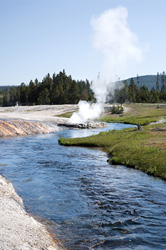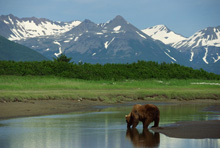Is the Predicted Yellowstone Earthquake Devastation of North America on its Way?
by www.SixWise.com
The millions of visitors that come to Yellowstone National Park every year marvel at the hot springs, steam vents and geysers -- but likely don’t think twice about what’s going on below the surface.
In some areas, partially molten rock is gurgling just a few miles below the surface, because Yellowstone is actually home to an active, underground volcano system. Some have even argued that Yellowstone is one of the largest active volcanoes in the world.
|

The Yellowstone National Park area is an active volcanic-tectonic area averaging 1,000 to 2,000 earthquakes a year!
|
The area’s famous geysers and hot springs are a direct result of Yellowstone’s geologic activity.
"That's just the surface manifestation of the enormous amount of heat that's being released through the system," Robert Smith, a professor of geophysics at the University of Utah and director of the Yellowstone Seismic Network, told the Associated Press.
So when an unusual sequence of earthquakes began occurring in the park on December 27, 2008, scientists sat up and took notice.
"They're certainly not normal," Smith said. "We haven't had earthquakes in this energy or extent in many years."
The Unusual 2008-2009 Yellowstone Earthquake Swarm
During the period beginning December 27, 2008 and continuing through January 2009, over 500 earthquakes, some as large as magnitude 3.9, were recorded by an automated earthquake system at Yellowstone. While earthquake swarms have been reported in the area in the past, it is very unusual for so many earthquakes to occur over several days.
According to the Yellowstone Volcano Observatory (YVO), which was formed by the U.S. Geological Survey, the University of Utah, and Yellowstone National Park to continually monitor volcanic activity in the park:
“This earthquake sequence is the most intense in this area for some years … The swarm is in a region of historical earthquake activity and is close to areas of Yellowstone famous hydrothermal activity. Similar earthquake swarms have occurred in the past in Yellowstone without triggering steam explosions or volcanic activity. Nevertheless, there is some potential for hydrothermal explosions and earthquakes may continue or increase in magnitude. There is a much lower potential for related volcanic activity.”
Yellowstone’s Explosive Past
There have been three extremely large explosive eruptions at Yellowstone in the past 2.1 million years. During these eruptions, the most recent of which occurred about 640,000 years ago, a layer of ash covered half of North America and chemicals and ash were blown around the planet, causing a notable decrease in temperatures worldwide.
So far, Yellowstone has had gigantic eruptions about once every 600,000 to 800,000 years. Since it's been about 640,000 years since the last one, this theoretically means there could be a catastrophic eruption at any time. While scientists say it’s extremely unlikely that a huge eruption will occur at Yellowstone in this century or even millennium, they expect that it will erupt at some point in the future.
As YVO monitors the park, they say they'd be able to detect a catastrophic eruption anywhere from weeks to years before it occurred, and would be tipped off by strong earthquake swarms, rapid ground deformation and other intense precursory activity.
Should a super-eruption be detected, they say, nothing much could be done.
"The temperatures, pressures, physical characteristics of partially molten rock, and the immensity of the magma chamber are beyond man's ability to influence -- much less control," says YVO.
|

Alaska is actually the most earthquake-prone state and one of the most seismically active regions in the world. Alaska experiences a magnitude 7 earthquake almost every year, and a magnitude 8 or greater earthquake on average every 14 years, according to the USGS.
|
If Yellowstone did erupt in the more near future, the most likely type of eruption that would occur would be a hydrothermal eruption of steam or hot water that could blast out shallow craters.
At the next level would be a smaller volcanic eruption that could produce significant volumes of volcanic ash, pumice and lava, similar in magnitude to the 1980 eruption of Mt. St. Helens or the, much larger, 1991 Mount Pinatubo eruption.
How Likely are Earthquakes to Occur in Other Areas of the United States?
In the United States, earthquakes occur across the nation -- not just on the West Coast or in Alaska or Hawaii, as you may think.
Scientists estimate where future earthquakes may occur by studying the history of previous large earthquakes along with the rate at which strain accumulates in rock. However, these methods may not be completely reliable, nor are they capable of predicting more short-term (even one- or two-year) predictions.
That said, scientists do "forecast" future earthquakes using the best methods currently available. For instance, according to the U.S. Geological Survey (USGS), there is a 67 percent chance a major earthquake will occur in the San Francisco Bay area (and a 60 percent chance one will occur in Southern California) in the next three decades.
And there's an area of the United States that's as high a hazard for earthquakes as California, yet is rarely though of as such: It's the New Madrid region located right in the Central United States -- it stretches from just west of Memphis, Tennessee into southern Illinois.
According to the USGS and the Center for Earthquake Research and Information of the University of Memphis, it's estimated that in the next 50 years:
What to Do if You’re in an Earthquake
If an earthquake hits, follow these tips from the USGS to stay safe:
-
Stay indoors if possible.
-
Get under a desk or table and hold onto it.
-
Stay away from windows, fireplaces and large furniture or appliances that could fall over.
-
Don't run downstairs or outside while a building is shaking.
-
If you're outside, move into the open (away from buildings, power lines or other objects that could fall on you).
-
If you're driving, move out of traffic and stop your car if possible (don't stop on a bridge or under an overpass).
-
Stay in your car, and when you resume driving watch out for breaks in pavement, fallen rocks, etc.
-
If you're in a mountainous area, be especially cautious of falling rocks, landslides, trees, etc. that may have been loosened by the quake.
Recommended Reading
When (Not If, When) Will the Big Earthquake Hit the Midwest?
Earthquakes: They're Actually Happening in MOST U.S. States; When is the Next Big One?
Sources
Yellowstone Volcano Observatory January 2, 2009
Physorg.com December 30, 2008
The U.S. Geological Survey Earthquake Hazards Program
Discovery Channel: America’s Explosive Park